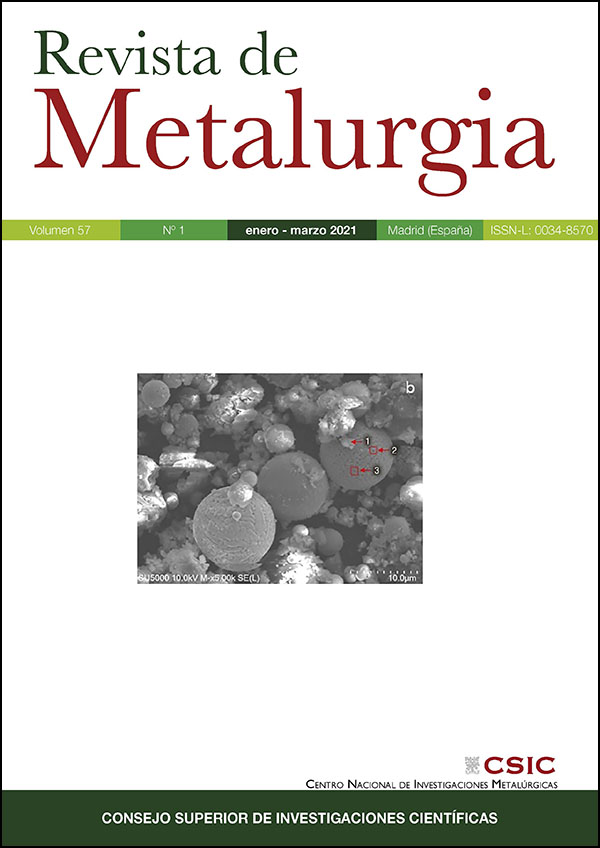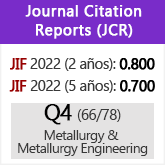La eliminación de metales tóxicos presentes en efluentes líquidos mediante resinas de cambio iónico. Parte XV: Iron(II)/H+/Lewatit TP208
DOI:
https://doi.org/10.3989/revmetalm.190Palabras clave:
Efluentes líquidos, Eliminación, Hierro(II), Lewatit TP208, Nanotubos de carbono de pared múltipleResumen
Se ha investigado el uso de la resina de intercambio catiónico Lewatit TP208 en la eliminación de hierro(II) de disoluciones acuosas. En esta eliminación, se han considerado varias variables experimentales, incluyendo, la velocidad de agitación aplicada al sistema, la temperatura, el pH de la disolución acuosa y la dosificación de la resina. Para velocidades de agitación incluidas en el intervalo 300-1200 min-1, el proceso de intercambio catiónico responde al modelo de difusión en la disolución acuosa. El aumento de la temperatura, entre 20 y 60 ºC, va asociado a un aumento de la concentración de hierro(II) cargado en la resina, por lo que el sistema tiene un carácter endotérmico. La variación del pH del medio acuoso hacia pH ácidos (desde 5 a 1) da lugar a una disminución en la carga del metal en la resina. Asimismo, la dosificación de la resina Lewatit TP208 afecta a la eliminación del hierro(II) de la disolución acuosa, los resultados experimentales se ajustan a la isoterma de Freundlich. Los modelos cinéticos asociados a este sistema dependen también de la dosificación de la resina: usando la concentración de resina más alta (1 g·L-1) los datos experimentales se ajustan (r2= 0,999) al modelo de pseudo-segundo orden, mientras que con la concentración de resina más baja (0,13 g·L-1) el modelo cinético es el primer-orden (r2= 0,997). Los resultados experimentales obtenidos con la resina Lewatit TP208 se han comparado con los obtenidos con otras resinas de intercambio catiónico y con el uso de nanotubos de carbono de pared múltiple. El hierro(II), cargado en la resina, puede ser eluido mediante el uso de disoluciones ácidas.
Descargas
Citas
Alguacil, F.J., Coedo, A.G., Dorado, T., Padilla, I. (2002). The removal of toxic metals from liquid effluents by ion exchange resins. Part I: chromium(VI)/sulphate/Dowex 1x8. Rev. Metal. 38 (4), 306-311. https://doi.org/10.3989/revmetalm.2002.v38.i4.412
Alguacil, F.J. (2002). The removal of toxic metals from liquid effluents by ion exchange resins. Part II: cadmium(II)/sulphate/Lewatit TP260. Rev. Metal. 38 (5), 348-352. https://doi.org/10.3989/revmetalm.2002.v38.i5.418
Alguacil, F.J. (2003). The removal of toxic metals from liquid effluents by ion exchange resins. Part III: copper(II)/sulphate/ Amberlite 200. Rev. Metal. 39 (3), 205-209. https://doi.org/10.3989/revmetalm.2003.v39.i3.330
Alguacil, F.J., Lopez, F.A., Rodriguez, O., Martinez-Ramirez, S., Garcia-Diaz, I. (2016). Sorption of indium (III) onto carbon nanotubes. Ecotoxicol. Environ. Safe. 130, 81-86. https://doi.org/10.1016/j.ecoenv.2016.04.008
Alguacil, F.J., Garcia-Diaz, I., Lopez, F., Rodriguez, O. (2017). Removal of Cr(VI) and Au(III) from aqueous streams by the use of carbon nanoadsorption technology. Desalin. Water Treat. 63, 351-356. https://doi.org/10.5004/dwt.2017.0264
Alguacil, F.J. (2017a). The removal of toxic metals from liquid effluents by ion exchange resins. Part IV: chromium(III)/ H+/Lewatit SP112. Rev. Metal. 53 (2), e093.
Alguacil, F.J. (2017b). The removal of toxic metals from liquid effluents by ion exchange resins. Part V: nickel(II)/ H+/Dowex C400. Rev. Metal. 53 (4), e105.
Alguacil, F.J. (2018a). The removal of toxic metals from liquid effluents by ion exchange resins. Part VI: manganese(II)/H+/Lewatit K2621. Rev. Metal. 54 (2), e116.
Alguacil, F.J. (2018b). The removal of toxic metals from liquid effluents by ion exchange resins. Part VII: manganese(VII)/H+/Amberlite 958. Rev. Metal. 54 (3), e125.
Alguacil, F.J., Escudero, E. (2018). The removal of toxic metals from liquid effluents by ion exchange resins. Part VIII: arsenic( III)/OH-/Dowex 1x8. Rev. Metal. 54 (4), e132.
Alguacil, F.J. (2019a). The removal of toxic metals from liquid effluents by ion exchange resins. Part IX: lead(II)/H+/Amberlite IR120. Rev. Metal. 55 (1), e138.
Alguacil, F.J. (2019b). The removal of toxic metals from liquid effluents by ion exchange resins. Part X: antimony(III)/H+/Ionac SR7. Rev. Metal. 55 (3), e152.
Alguacil, F.J. (2019c). The removal of toxic metals from liquid effluents by ion exchange resins. Part XI: Cobalt(II)/H+/Lewatit TP260. Rev. Metal. 55 (4), e154.
Alguacil, F.J., Escudero, E. (2020). The removal of toxic metals from liquid effluents by ion exchange resins. Part XII: Mercury(II)/H+/Lewatit SP112. Rev. Metal. 56 (1), e160.
Alguacil, F.J. (2020a). The removal of toxic metals from liquid effluents by ion exchange resins. Part XIII: zinc(II)/H+/Lewatit OC-1026. Rev. Metal. 56 (3), e172.
Alguacil, F.J. (2020b). The removal of toxic metals from liquid effluents by ion exchange resins. Part XIV: Indium(III)/H+/Dowex-400. Rev. Metal. 56 (4), e184.
Bezzina, J.P., Ruder, L.R., Dawson, R., Ogden, M.D. (2019). Ion exchange removal of Cu(II), Fe(II), Pb(II)and Zn(II)from acid extracted sewage sludge - Resin screening in weak acid media. Water Res. 158, 257-267. https://doi.org/10.1016/j.watres.2019.04.042
Bezzina, J.P., Robshaw, T., Dawson, R., Ogden, M.D. (2020). Single metal isotherm study of the ion exchange removal of Cu(II), Fe(II), Pb(II) and Zn(II) from synthetic acetic acid leachate. Chem. Eng. J. 394, 124862. https://doi.org/10.1016/j.cej.2020.124862
Botelho Junior, A.B., Vicente, A.D.A., Romano Espinosa, D.C., Soares Ten.rio, J.A. (2020). Effect of iron oxidation state for copper recovery from nickel laterite leach solution using chelating resin. Sep. Sci. Technol. 55 (4), 788-798. https://doi.org/10.1080/01496395.2019.1574828
Desouky, A.M. (2018). Remove heavy metals from groundwater using carbon nanotubes grafted with amino compound. Sep. Sci. Technol. 53 (1), 1698-1702. https://doi.org/10.1080/01496395.2018.1441304
Frohlich, A.C., Foletto, E.L., Dotto, G.L. (2019). Preparation and characterization of NiFe2O4/activated carbon composite potential magnetic adsorbent for removal of ibuprofen and ketoprofen pharmaceuticals from aqueous solutions. J. Clean. Prod. 229, 828-837. https://doi.org/10.1016/j.jclepro.2019.05.037
Hao, J., Dai, C., Liu, Y., Yang, Q. (2017). Removal of copper through adsorption by magnesium hydroxide nanorod. Desalin. Water Treat. 90, 252-261. https://doi.org/10.5004/dwt.2017.21420
Lopez Diaz-Pavon, A., Cerpa, A., Alguacil, F.J. (2014). Processing of indium(III) solutions via ion exchange with Lewatit K-2621 resin. Rev. Metal. 50 (2), e010. https://doi.org/10.3989/revmetalm.010
Ma, W.J., Chen, T.H., Chen, D., Liu, H.B., Cheng, P., Zhang, Z.X., Tao, Q., Zhang, Y.Z. (2019). Removal of Fe(II), Mn(II), and NH4 +-N by using δ-MnO2 coated zeolite. Huanjing Kexue/Environ. Sci. 40 (10), 4553-4561.
Moghimi, F., Jafari, A.H., Yoozbashizadeh, H., Askari, M. (2020). Adsorption behavior of Sb(III) in single and binary Sb(III)-Fe(II) systems on cationic ion exchange resin: Adsorption equilibrium, kinetic and thermodynamic aspects. Trans. Nonferr. Metal. Soc. China 30 (1), 236-248. https://doi.org/10.1016/S1003-6326(19)65195-2
Puigdomenech, I. (2020). MEDUSA Program. www.kth.se. Van Dat, D., Van Thuan, L., Hoang Sinh, L., Dinh Hien, T., Hoai Thuong, N. (2019). Effectiveness of calcium deficiency in nanosized hydroxyapatite for removal of Fe(II), Cu(II), Ni(II) and Cr(VI) ions from aqueous solutions. J. Nano Res. 56, 17-27. https://doi.org/10.4028/www.scientific.net/JNanoR.56.17
WHO (2003). Iron in drinking-water. WHO guidelines for drinking- water quality. https://www.who.int/water_sanitation_health/dwq/chemicals/iron.pdf . www.who.int
Wust, W.F., Kober, R., Schlicker, O., Dahme, A. (1999). Combined zero- and first-order kinetic model of the degradation of TCE and cis-DCE with commercial iron. Environ. Sci. Technol. 33, 4304-4309. https://doi.org/10.1021/es980439f
Zhou, G., Li, Q., Sun, P., Guan, W., Zhang, G., Cao, Z., Zeng, L. (2018). Removal of impurities from scandium chloride solution using 732-type resin. J. Rare Earths 36 (3), 311-316. https://doi.org/10.1016/j.jre.2017.09.009
Publicado
Cómo citar
Número
Sección
Licencia
Derechos de autor 2021 Consejo Superior de Investigaciones Científicas (CSIC)

Esta obra está bajo una licencia internacional Creative Commons Atribución 4.0.
© CSIC. Los originales publicados en las ediciones impresa y electrónica de esta Revista son propiedad del Consejo Superior de Investigaciones Científicas, siendo necesario citar la procedencia en cualquier reproducción parcial o total.Salvo indicación contraria, todos los contenidos de la edición electrónica se distribuyen bajo una licencia de uso y distribución “Creative Commons Reconocimiento 4.0 Internacional ” (CC BY 4.0). Puede consultar desde aquí la versión informativa y el texto legal de la licencia. Esta circunstancia ha de hacerse constar expresamente de esta forma cuando sea necesario.
No se autoriza el depósito en repositorios, páginas web personales o similares de cualquier otra versión distinta a la publicada por el editor.


















